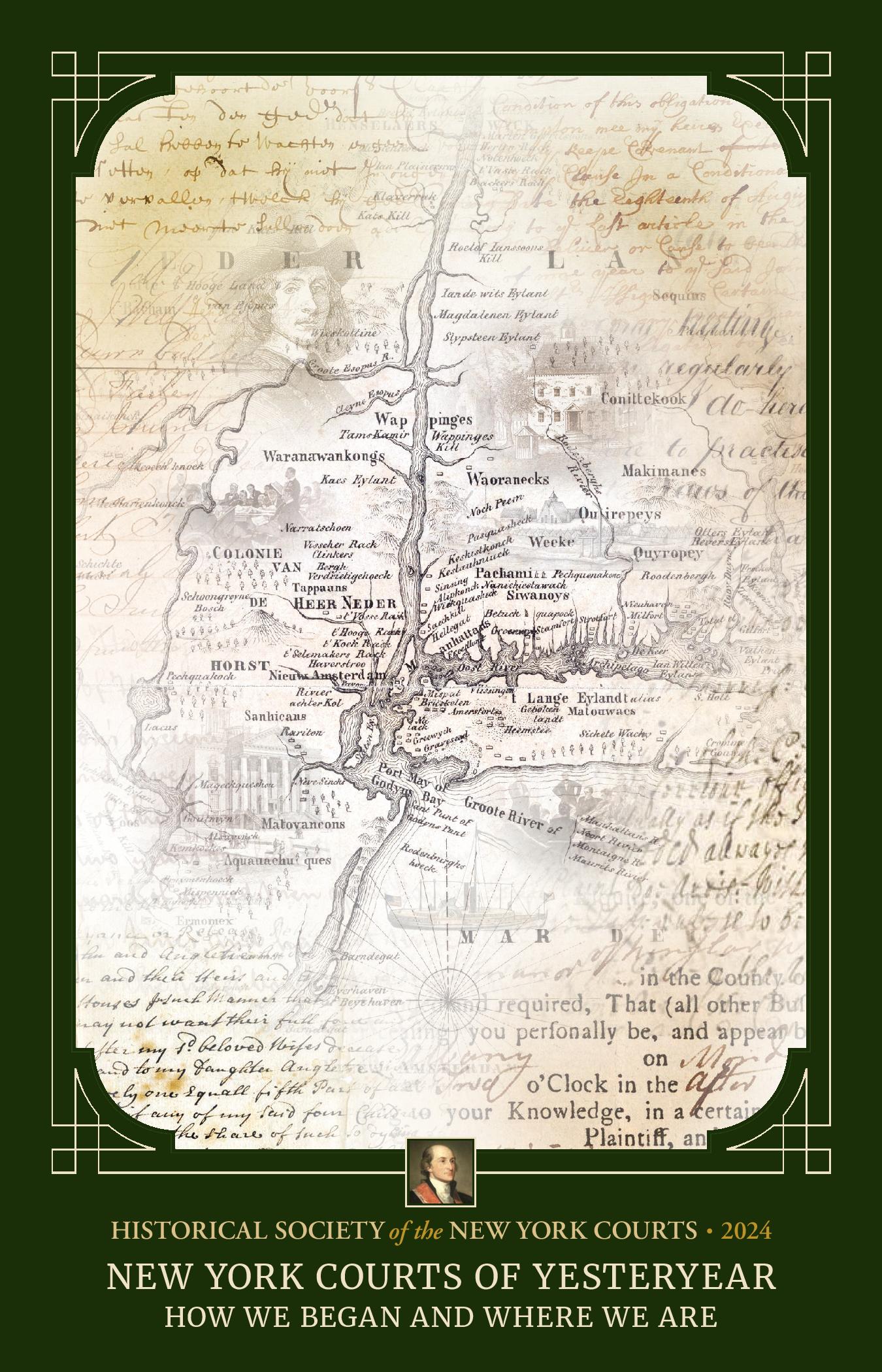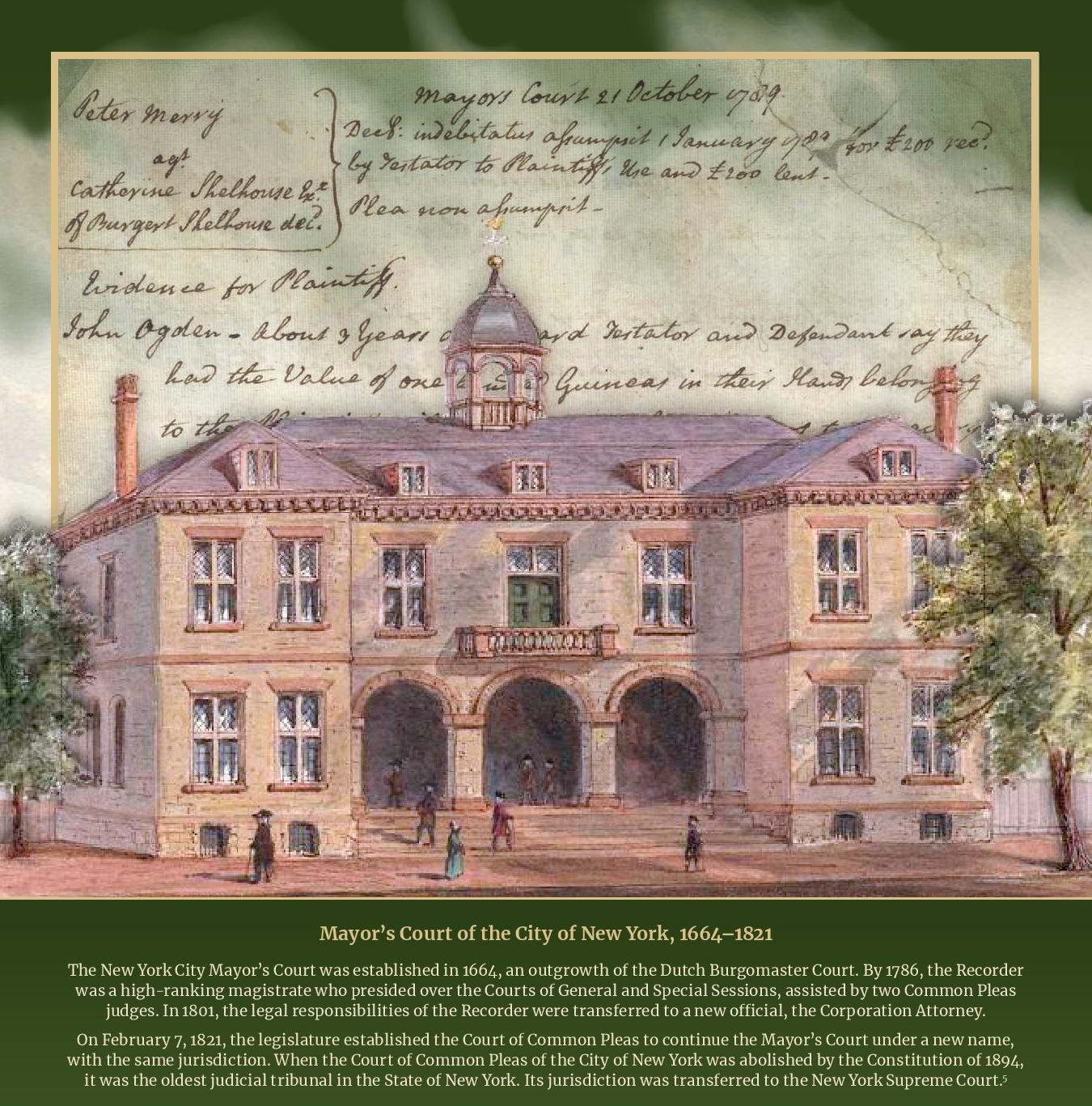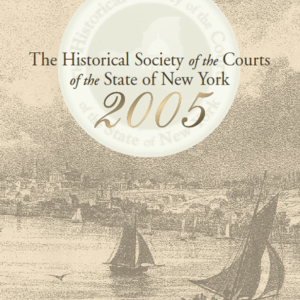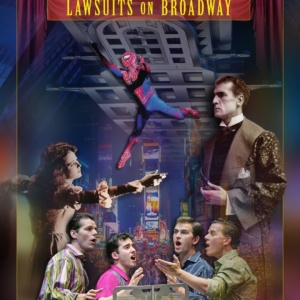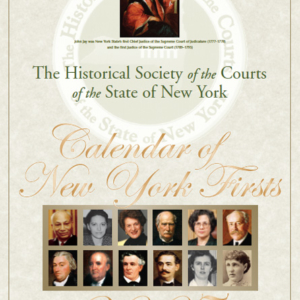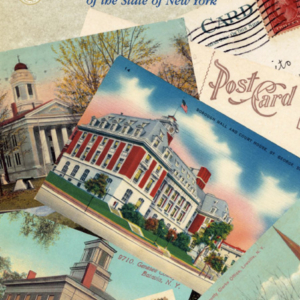Description
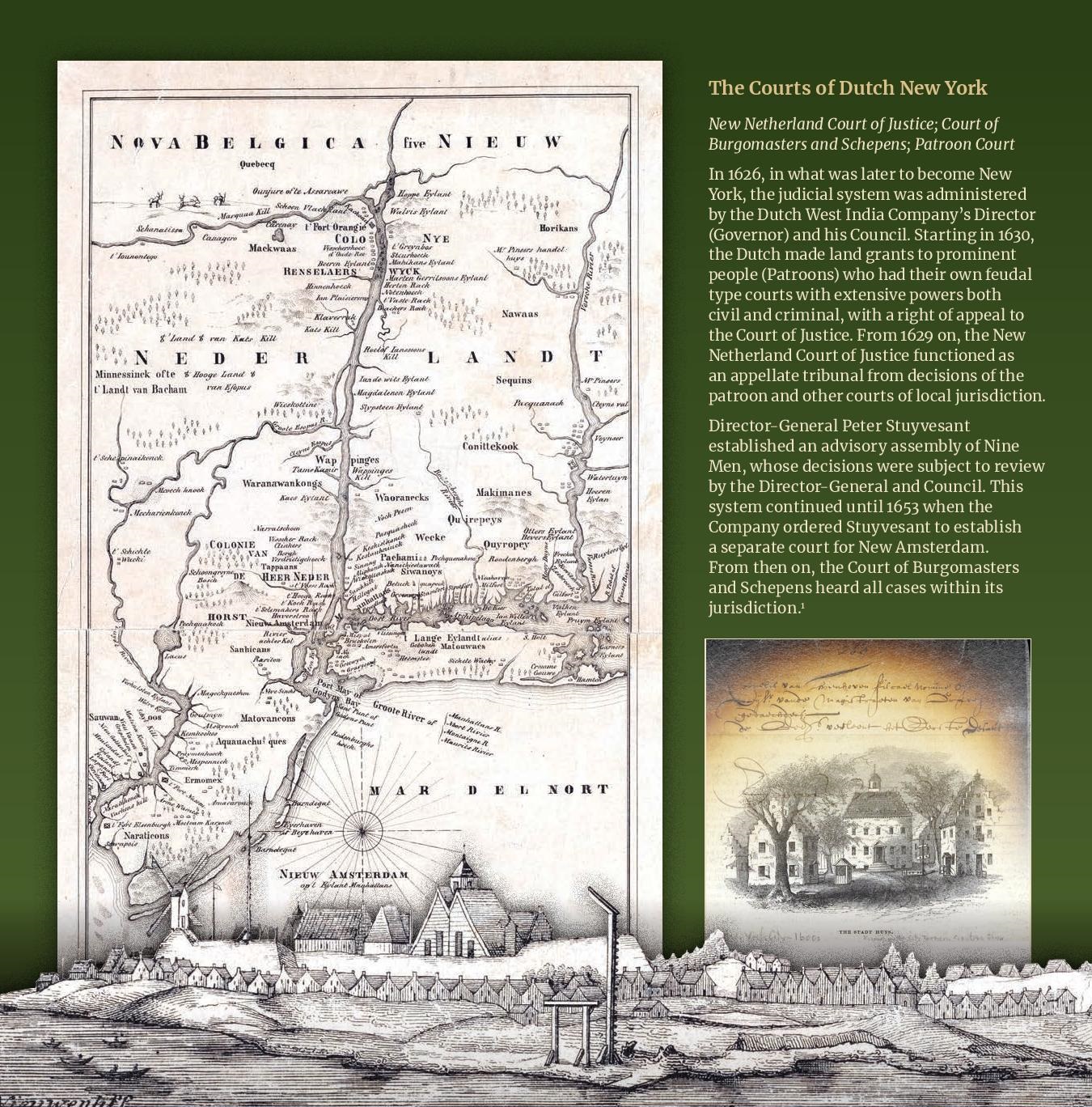
The Courts of Dutch New York
New Netherland Court of Justice; Court of Burgomasters and Schepens; Patroon Court
In 1626, in what was later to become New York, the judicial system was administered by the Dutch West India Company’s Director (Governor) and his Council. The Dutch had made land grants to prominent people (Patroons) who had their own feudal type courts with extensive powers both civil and criminal, with a right of appeal to the Court of Justice. From 1629 on, the New Netherland Court of Justice functioned as an appellate tribunal from decisions of the patroon and other courts of local jurisdiction.
Director-General Peter Stuyvesant established an advisory assembly of Nine Men, whose decisions were subject to review by the Director-General and Council. This system continued until 1653 when the Company ordered Stuyvesant to establish a separate court for New Amsterdam. From then on, the Court of Burgomasters and Schepens heard all cases within its jurisdiction.[1]
[1] Sources and further reading: Historical Society of the New York Courts, The New Netherland Court of Justice, 1626-1674, https://history.nycourts.gov/about_period/new-netherland-court-justice/; Albert M. Rosenblatt and Julia C. Rosenblatt, Opening Statements: Law, Jurisprudence, and the Legacy of Dutch New York (SUNY Press 2013); Henry W. Scott, The Courts of the State of New York, (1909), 33; The Records of New Amsterdam from 1653 to 1674 Anno Domini, 7 vols., Edmund B. O’Callaghan, Berthold Fernow, ed., 1897, reprint 1976 Genealogical Publishing, volumes 1-4; James W. Brooks, History of the Court of Common Pleas of the City and County of New York (1896), 9-15. As to Dutch Courts in New Netherland, see, generally, Jaap Jacobs, New Netherland: A Dutch Colony in Seventeenth-Century America (Brill 2005) at 347 et seq.
For general reading throughout this calendar as to New York State constitutional changes in courts, see Peter J. Galie, Ordered Liberty (1966).
Images
New York City’s first city hall, the Stadt Huys, which served as a courthouse for the Dutch settlement of New Amsterdam. The New York Public Library, The Miriam and Ira D. Wallach Division of Art, Prints and Photographs: Picture Collection.
A letter from the Director-General to the Burgomasters and Schepens urging them to take actions on matters including repairing the city’s fortifications and paying the ministers’ salaries, 1654. New York State Archives, New Netherland, Council, Dutch colonial minutes, 1648-1656, Series A1809, Volume 5.
Adriaen van der Donck’s map of New Netherland, 1656. The New York Public Library, Lionel Pincus and Princess Firyal Map Division.
February 2024
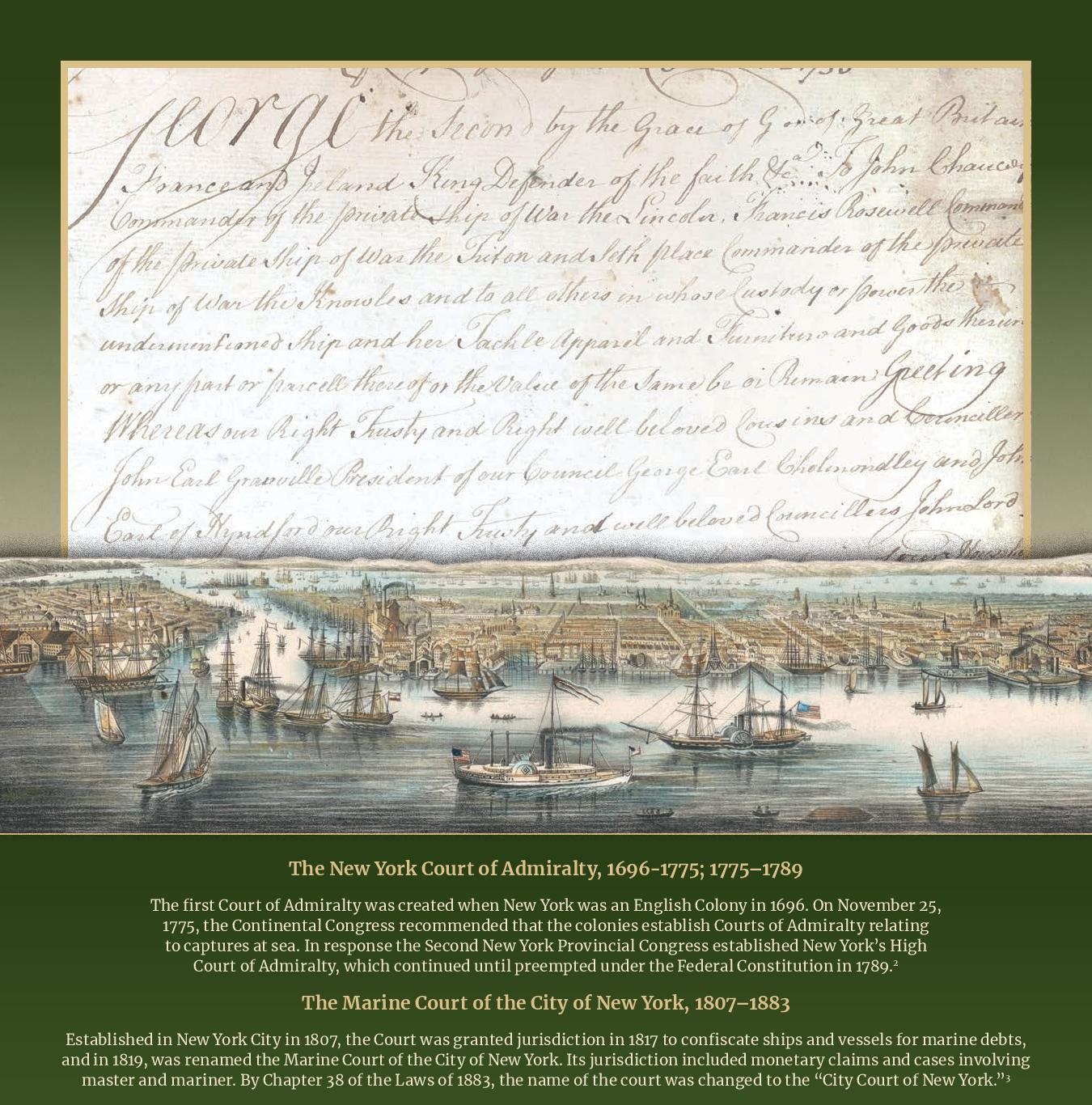
The New York Court of Admiralty, 1696-1775; 1775-1789
The first Court of Admiralty was created when New York was an English Colony in 1696. On November 25, 1775, the Continental Congress recommended that the colonies establish Courts of Admiralty relating to captures at sea, and in response to the Second New York Provincial Congress, established New York’s High Court of Admiralty, which continued until preempted under the Federal Constitution in 1789.[1]
The Marine Court of the City of New York, 1807-1883
Established in New York City in 1807, the Court was granted jurisdiction in 1817 to confiscate ships and vessels for marine debts, and in 1819, was renamed the Marine Court of the City of New York. Its jurisdiction included monetary claims and cases involving master and mariner. By Chapter 38 of the Laws of 1883, the name of the court was changed to the “City Court of New York”[2]
[1] Sources and further reading: William Smith, Jr., The History of the Province of New-York, ed. Michael Kammen (Cambridge, Mass.: 1972), vol. 1, pp. 267-68 has a brief description of the Court of Admiralty. Edgar A. Werner, Civil List and Constitutional History of the Colony and State of New York (1891), pp. 371-72 has a history of the Court of Court of Admiralty, stating that the court was formally organized in 1678.
[2] Sources and further reading: See Historical Society of the New York Courts, The New York Court of Admiralty, 1775-1789, https://history.nycourts.gov/case/court-admiralty/; Case Papers of the Court of Admiralty of the State of New York, 1784-1788, Washington, D.C.: National Archives & Records Administration, Central Plains Region, 1973, online at https://www.familysearch.org/search/catalog/394406?availability=Family%20History%20Library; Historical Society of the New York Courts, The Marine Court of the City of New York, 1807-1883, https://history.nycourts.gov/case/marine-court/.
Images
Colonial records of the New York Court of Vice Admiralty, c. 1760. The New York Public Library, Manuscripts and Archives Division.
A print showing a view of New York harbor and its waterfront buildings, with ships in the foreground, 1850. Library of Congress, Prints & Photographs Division, LC-DIG-pga-07068.
March 2024
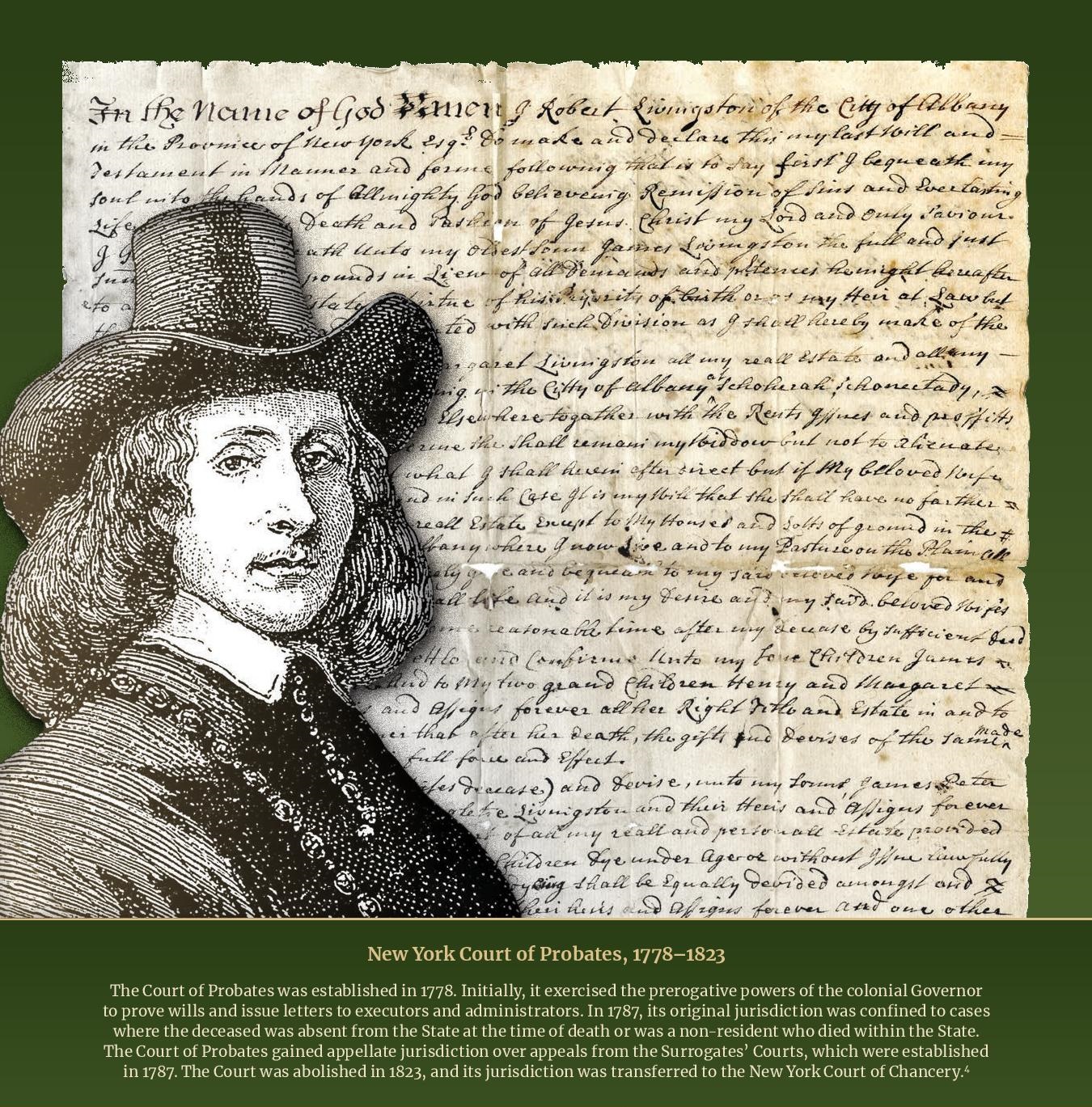
New York Court of Probates, 1778-1823
The Court of Probates was established in 1778. Initially, it exercised the prerogative powers of the colonial Governor to prove wills and issue letters to executors and administrators. In 1787, its original jurisdiction was confined to cases where the deceased was absent from the State at the time of death or was a non-resident who died within the State. The Court of Probates gained appellate jurisdiction over appeals from the Surrogates’ Courts, which were established in 1787. The Court was abolished in 1823, and its jurisdiction was transferred to the New York Court of Chancery.[1]
[1] Sources and further reading: see, Historical Society of the New York Courts, Probate Court, 1778-1823, https://history.nycourts.gov/case/probate-court/; New York State Archives, Probate Records, https://www.archives.nysed.gov/research/res_topics_legal_probate_precourts; Caujolle’s Appeal, 9 Abb. Pr. 393, 399 (1857).
Images
Robert Livingston the Elder’s will, 1725. New York State Archives. New York (State). Court of Probates. Probated wills. J0038-82. Box 41, AL6, Robert Livingston, Jr.
Portrait of Robert Livingston, prominent colonial New York government official and ancestor of New York’s first Chancellor Robert R. Livingston, when he was a young man. Originally published in Cuyler Reynolds, Albany Chronicles (Albany: 1906), facing p. 180, courtesy New York State Library, Manuscripts & Special Collections.
April 2024
Mayor’s Court of the City of New York, 1664 – 1821
The New York City Mayor’s Court was established in 1664, an outgrowth of the Dutch Burgomaster Court. By 1786, the Recorder was a high-ranking magistrate who presided over the Courts of General and Special Sessions, assisted by two Common Pleas judges. In 1801, the legal responsibilities of the Recorder were transferred to a new official, the Corporation Attorney.
On February 7, 1821, the legislature established the Court of Common Pleas to continue the Mayor’s Court under a new name, with the same jurisdiction. When the Court of Common Pleas of the City of New York was abolished by the Constitution of 1894, it was the oldest judicial tribunal in the State of New York. Its jurisdiction was transferred to the New York Supreme Court.[1]
[1] Sources and further reading: Mayor’s court minutes, 1674-1821, (Salt Lake City, Utah: Filmed by the Genealogical Society of Utah, 1977), https://www.familysearch.org/search/catalog/418909?availability=Family%20History%20Library; New York City Mayor’s Court trial minutes, Manuscripts and Archives Division, The New York Public Library, https://archives.nypl.org/mss/2182; Select cases of the Mayor’s Court of New York City, 1674-1784, Richard B. Morris, ed., https://searchworks.stanford.edu/view/991668. See, also, Connors Genealogy, Manhattan: Court Records, http://sites.rootsweb.com/~nynewyo2/CourtRecords.htm; New York City and New York State Legal Documents, Manuscripts and Archives Division, The New York Public Library, https://archives.nypl.org/mss/18159#:~:text=In%20approximately%201699%2C%20the%20Mayor’s,the%20basement%2C%20the%20municipal%20jail; Historical Society of the New York Courts, Court of Common Pleas, 1686-1895, https://history.nycourts.gov/court/court-common-pleas/.
Images
The Old City Hall on Wall Street, the original home of the New York City Mayor’s Court. The New York Public Library, The Miriam and Ira D. Wallach Division of Art, Prints and Photographs: Print Collection, Emmet Collection of Manuscripts Etc. Relating to American History.
Trial Minutes of the New York City Mayor’s Court, 1789. The New York Public Library, Manuscripts and Archives Division.
May 2024
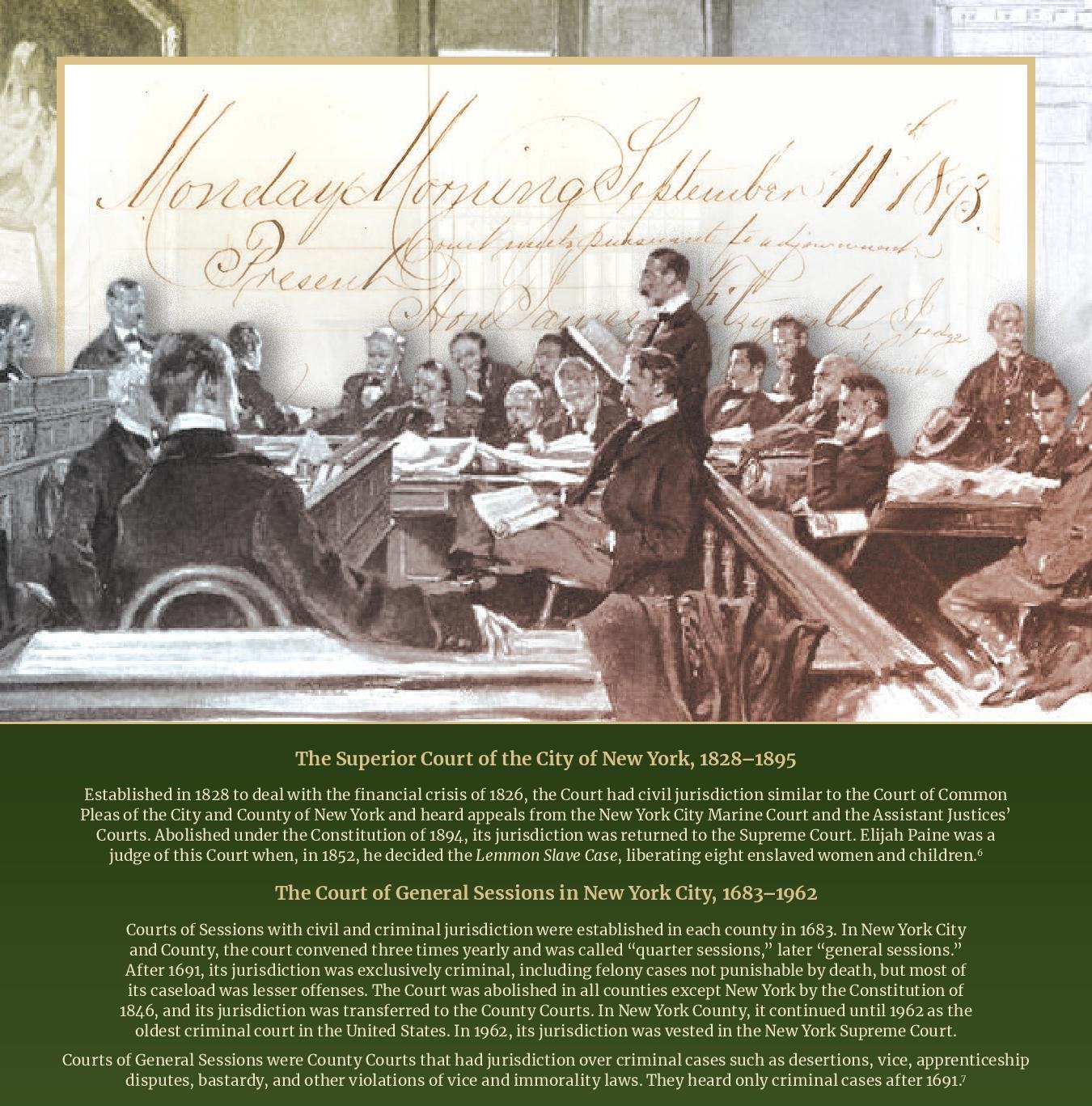
The Superior Court of the City of New York, 1828-1895
Established in 1828 to deal with the financial crisis of 1826, the Court had civil jurisdiction similar to the Court of Common Pleas the City and County of New York and heard appeals from the New York City Marine Court and the Assistant Justices’ Courts. Abolished under the Constitution of 1894, its jurisdiction was returned to the Supreme Court. Elijah Paine was a judge of this Court when, in 1852, he decided the Lemmon Slave Case, liberating eight enslaved women and children.[1]
The Court of General Sessions in New York City, 1683-1962
Courts of Sessions with civil and criminal jurisdiction were established in each county in 1683. In New York City and County, the court convened three times yearly and was called “quarter sessions,” later “general sessions.” After 1691, its jurisdiction was exclusively criminal, including felony cases not punishable by death, but most of its caseload was lesser offenses. The Court was abolished in all counties except New York by the Constitution of 1846, and its jurisdiction was transferred to the County Courts. In New York County, it continued until 1962 as the oldest criminal court in the United States. In 1962, its jurisdiction was vested in the New York Supreme Court.
Courts of General Sessions were County Courts that had jurisdiction over criminal cases such as desertions, vice, apprenticeship disputes, bastardy, and other violations of vice and immorality laws. They heard only criminal cases after 1691.[2]
[1] Sources and further reading: David Graham, Jr., A Treatise on the Organization and Jurisdiction of the Courts of Law and Equity, in the State of New York (New York: 1839).
[2] Sources and further reading: Kenneth Scott, New York City Court Records, 1684-1804: Genealogical Data from the Court of Quarter Sessions, (National Genealogical Society 1982); http://sites.rootsweb.com/~nynewyo2/CourtRecords.htm.. Records contain lists of persons involved in cases of stealing, assault, battery and illegitimacy. Kenneth Scott, New York City Court Records, 1801-1804: Genealogical Data from the Court of General Sessions, (National Genealogical Society 1988); Historical Society of the New York Courts, The Superior Court of the City of New York, 1828-1894, https://history.nycourts.gov/court/the-superior-court-of-the-city-of-new-york-1828-1894/ .
Images
Depiction of a trial held in the Court of General Sessions, 1901. The New York Public Library, The Miriam and Ira D. Wallach Division of Art, Prints and Photographs: Picture Collection.
Minutes of the Court of General Sessions, September 11, 1893, which includes Emma Goldman’s indictment for unlawful assembly. Courtesy NYC Municipal Archives.
June 2024
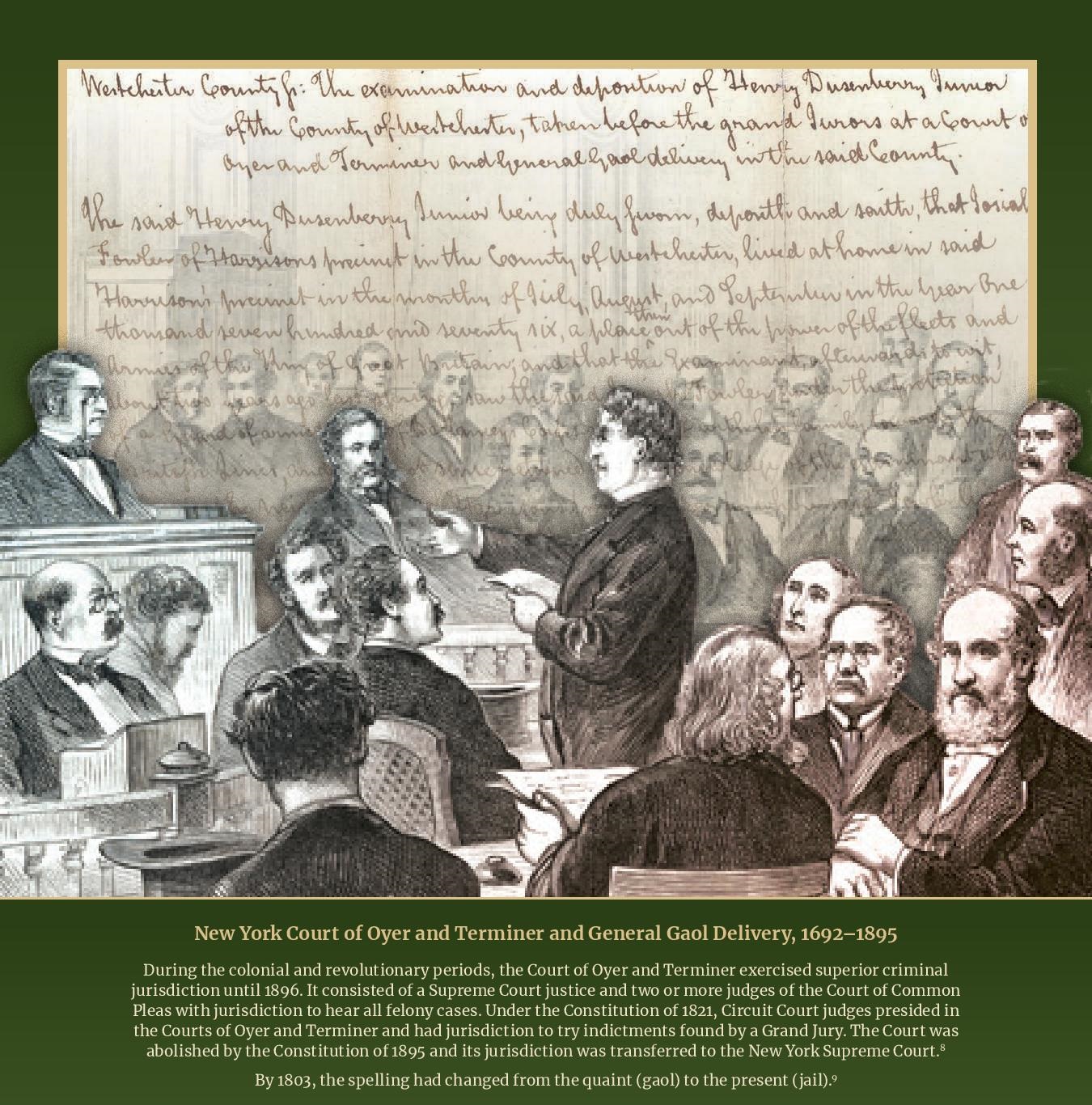
New York Court of Oyer and Terminer and General Gaol Delivery, 1692-1895
After the colonial and revolutionary periods, the Court of Oyer and Terminer continued to exercise superior criminal jurisdiction until 1895 and consisted of a Supreme Court justice and two or more judges of the Court of Common Pleas with jurisdiction to hear all felony cases. Under the Constitution of 1821, Circuit Court judges presided in the Courts of Oyer and Terminer and had jurisdiction to try indictments found by a Grand Jury. The Court was abolished by the Constitution of 1895 and its jurisdiction was transferred to the New York Supreme Court.[1]
By 1803, the spelling had changed from the quaint (gaol) to the present (jail).[2]
[1] Sources and further reading: Historical Society of the New York Courts, Court of Oyer and Terminer, 1788-1895, https://history.nycourts.gov/case/court-oyer-terminer/;
People v. Quimbo Appo, 18 How. Pr. 350, 354 (1859); People v. Youngs, 1 Cai. R. 36, 42 (1803); People v. Vlasto, 78 Misc. 2d 419, 421 (1974).
[2] State Act of the 21st March, 1801 (Rev. Laws of N. Y., sec. 1, vol. 1, p. 302).
Images
The trial of William M. “Boss” Tweed in the Court of Oyer and Terminer, New York County, February 15, 1873. The New York Public Library, The Miriam and Ira D. Wallach Division of Art, Prints, and Photographs: Print Collection.
Deposition in the Court of Oyer and Terminer, Westchester County, of Henry Dusenbury against Josiah Fowler, October 22, 1783. New York State Archives, New York (State), Supreme Court of Judicature (New York), Pleadings and Other Civil and Criminal Documents, JN522-17, P-0496.
July 2024
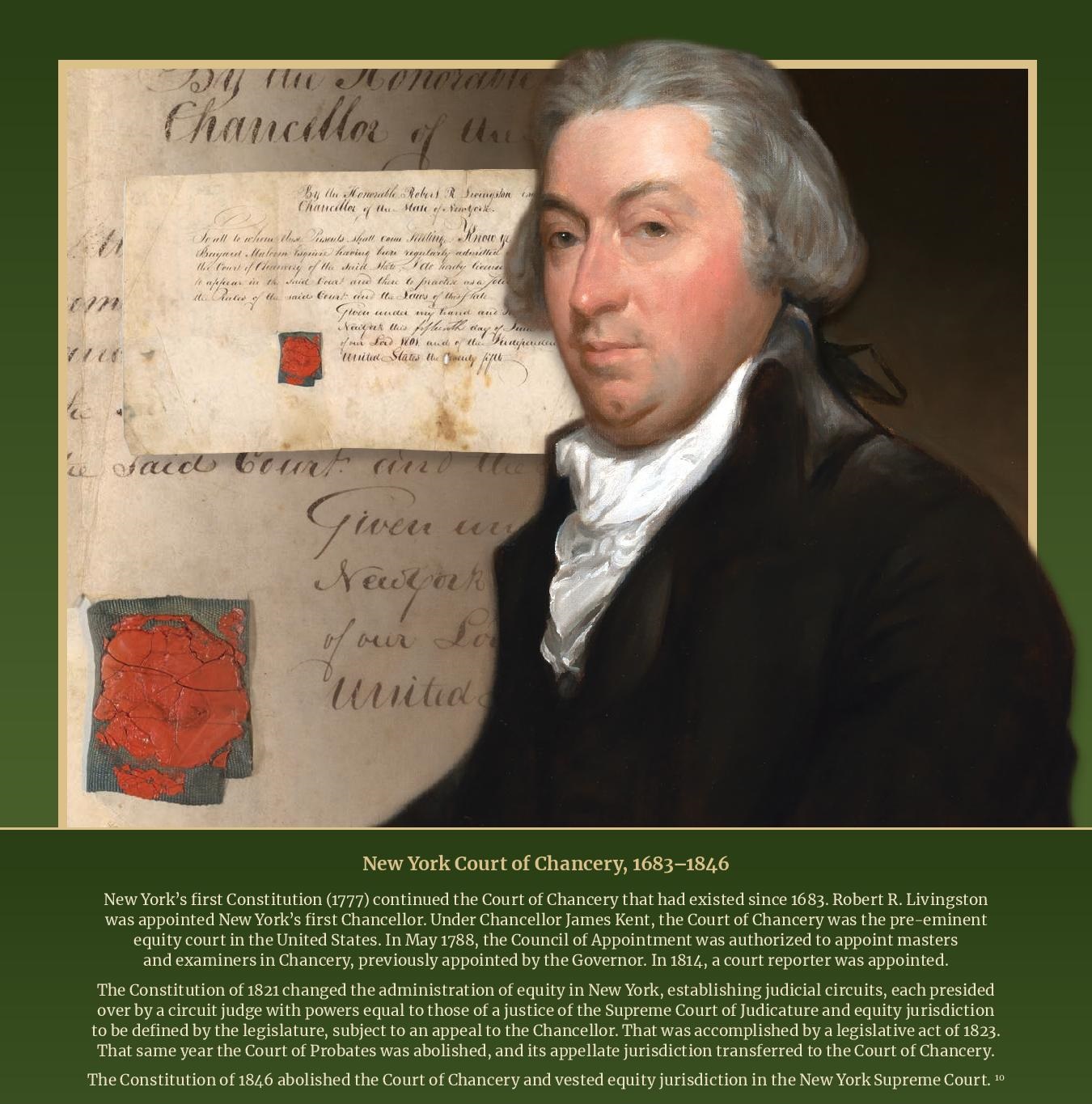
New York’s first Constitution (1777) continued the Court of Chancery that had existed since 1683. Robert R. Livingston was appointed New York’s first Chancellor. During the early decades of the State, the Court of Chancery was one of the pre-eminent courts in the United States. In May 1788, the Council of Appointment was authorized to appoint masters and examiners in Chancery, previously appointed by the Governor. In 1814, a court reporter was appointed.
The Constitution of 1821 changed the administration of equity in New York, establishing judicial circuits, each presided over by a circuit judge with powers equal to those of a justice of the Supreme Court of Judicature and equity jurisdiction to be defined by the legislature, subject to an appeal to the Chancellor. That was accomplished by a legislative act of 1823. That same year the Court of Probates was abolished, and its appellate jurisdiction transferred to the Court of Chancery.
The Constitution of 1846 abolished the Court of Chancery and vested equity jurisdiction in the New York Supreme Court.[1]
[1] Sources and further reading: Historical Society of the New York Courts, New York Court of Chancery, 1683-1846, https://history.nycourts.gov/case/court-chancery/; Social Networks and Archival Context, New York State Court of Chancery, https://snaccooperative.org/ark:/99166/w60k679w.
Images
License to practice before New York’s Court of Chancery for Samuel B. Malcom, directed by Chancellor Robert R. Livingston, 1801. The New York Public Library, Manuscripts and Archives Division, Schuyler-Malcom Family Papers.
Portrait of Robert R. Livingston, New York’s first Chancellor. The Diplomatic Reception Rooms, U.S. Department of State, Washington, D.C., funds donated Mrs. Walter E. Wolf, Jr., in memory of Isadore and Lillian Weinberg.
August 2024
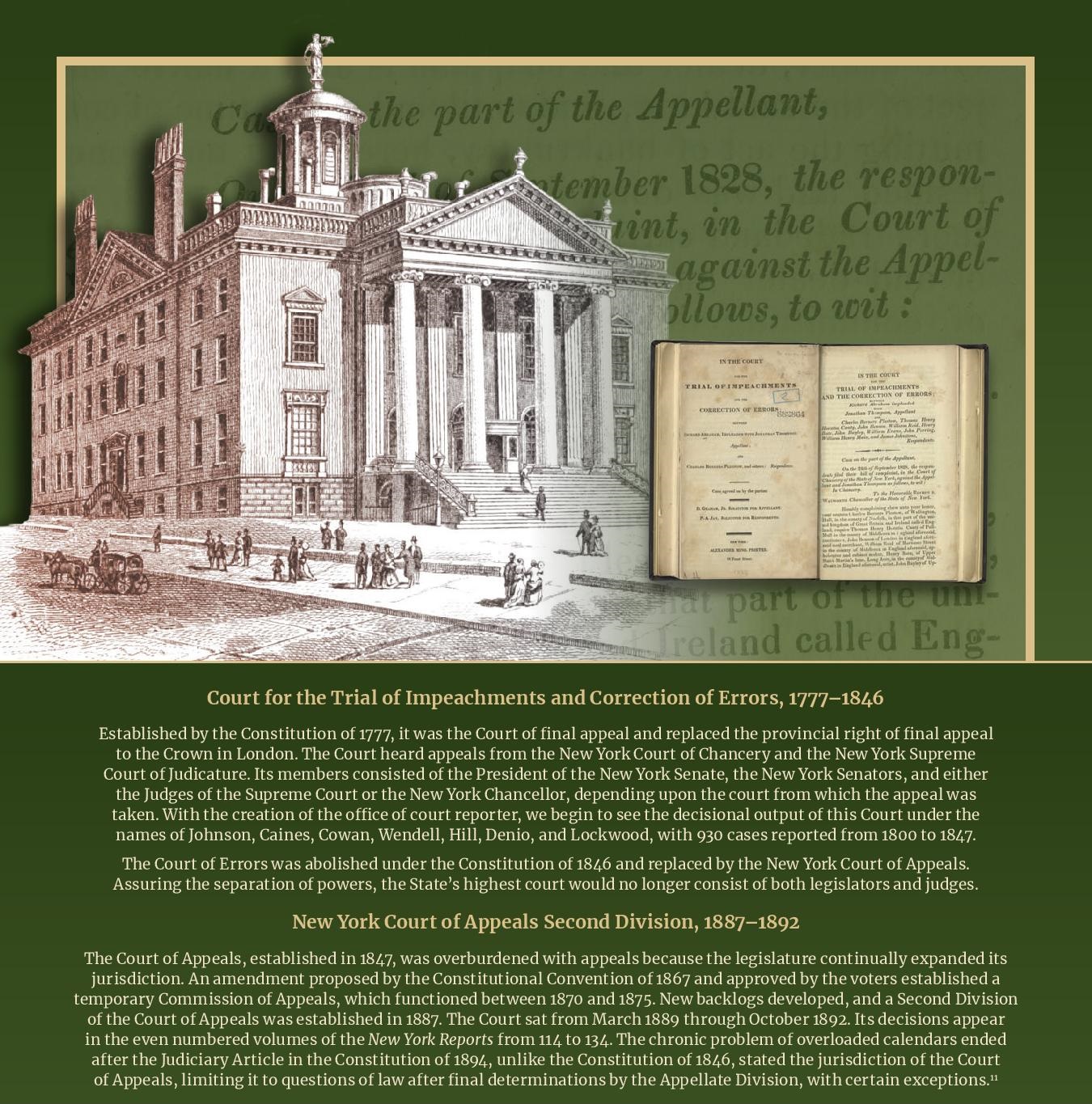
Court for the Trial of Impeachments and Correction of Errors, 1777-1846
Established by the Constitution of 1777, it was the Court of final appeal and replaced the provincial right of final appeal to the Crown in London. The Court heard appeals from the New York Court of Chancery and the New York Supreme Court of Judicature. Its members consisted of the President of the New York Senate, the New York Senators, and either the Judges of the Supreme Court or the New York Chancellor, depending upon the court from which the appeal was taken. With the creation of the office of court reporter, we begin to see the decisional output of this Court under the names of Johnson, Caines, Cowan, Wendell, Hill, Denio, and Lockwood, with 930 cases reported from 1800 to 1847.
The Court of Errors was abolished under the Constitution of 1846 and replaced by the New York Court of Appeals. Assuring the separation of powers, the State’s highest court would no longer consist of both legislators and judges.
New York Court of Appeals Second Division, 1887-1892
The Court of Appeals, established in 1847, was overburdened with appeals because the legislature continually expanded its jurisdiction. An amendment proposed by the Constitutional Convention of 1867 and approved by the voters established a temporary Commission of Appeals, which functioned between 1870 and 1875. New backlogs developed, and a Second Division of the Court of Appeals was established in 1887. The Court sat from March 1889 through October 1892. Its decisions appear in the even numbered volumes of the New York Reports from 114 to 134. The chronic problem of overloaded calendars ended after the Judiciary Article in the Constitution of 1894, unlike the Constitution of 1846, stated the jurisdiction of the Court of Appeals, limiting it to questions of law after final determinations by the Appellate Division, with certain exceptions.[1]
[1] Sources and further reading: Historical Society of the New York Courts, Court for the Trial of Impeachments and Corrections of Errors, 1777-1846, https://history.nycourts.gov/case/court-trial-impeachments-errors/; Albert M. Rosenblatt, The Judges of the New York Court of Appeals (2007) xxix-xxxi; Francis Bergan, The History of the New York Court of Appeals, 1847-1932, (1985) 132-136.
Images
Pages from In the Court for the Trial of Impeachments and the Correction of Errors: Between Richard Abraham, impleaded with J. Thompson, appellant; and C.B. Plestow and others: respondent, 1828. The New York Public Library, General Research Division.
Hon. Alton B. Parker, who served as a Judge of the Second Division, before becoming Chief Judge and later a presidential nominee, c. 1905. Library of Congress, Prints & Photographs Division, photograph by Harris & Ewing, LC-H25- 21321-BF.
September 2024
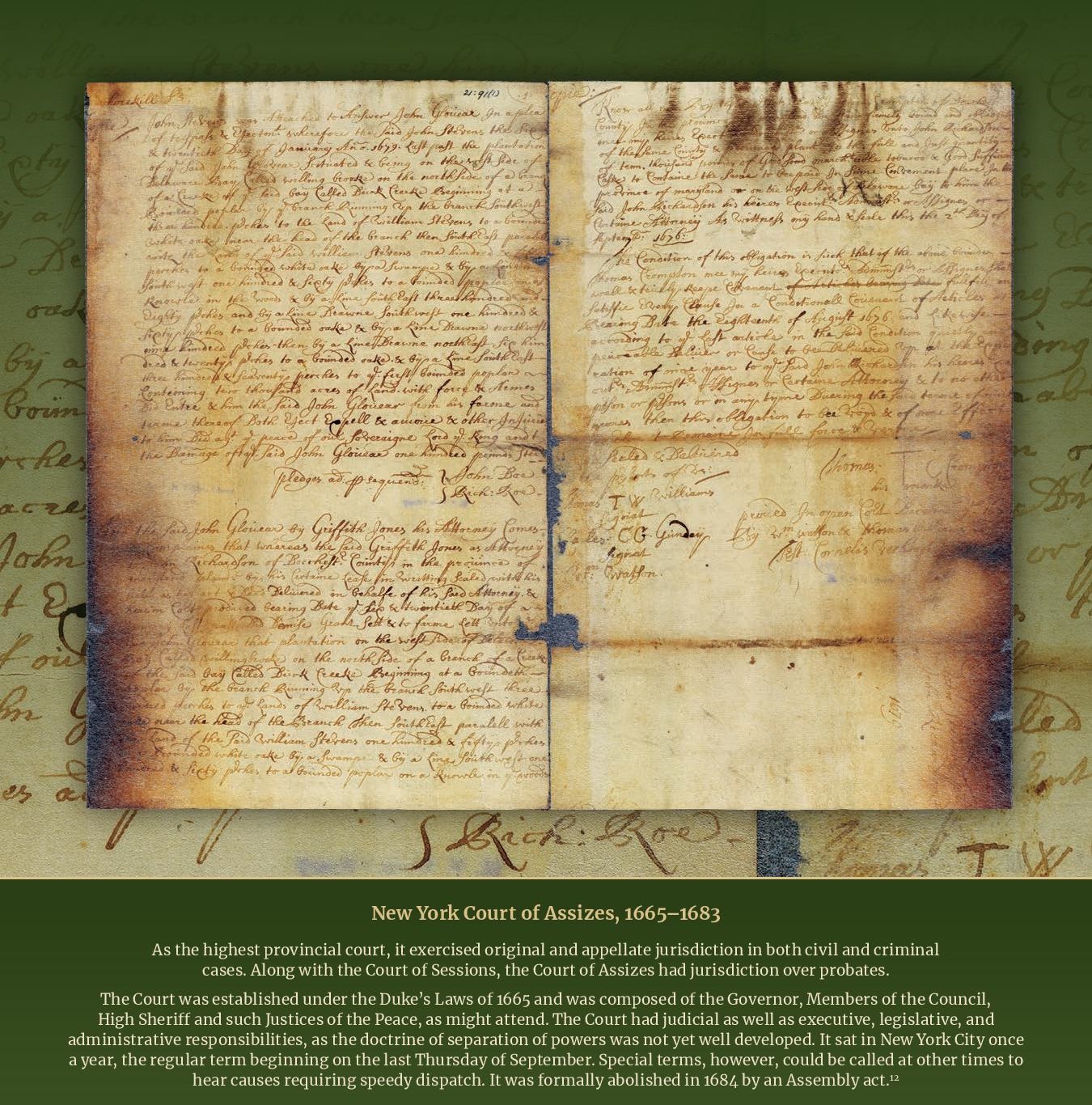
New York Court of Assizes, 1665-1683
As the highest provincial court, it was established in New York City to have original jurisdiction in both civil and criminal cases. Along with the Court of Sessions, the Court of Assizes had jurisdiction over probates.
The Court was established under the Duke’s Laws of 1665 and was composed of the Governor, Members of the Council, High Sheriff and such Justices of the Peace, as might attend. The Court had judicial as well as executive, legislative, and administrative responsibilities, as the doctrine of separation of powers was not yet well developed. It sat in New York once a year, the regular term beginning on the last Thursday of September. Special terms, however, could be called at other times to hear causes requiring speedy dispatch. It was formally abolished in 1684 by an Assembly act.[1]
[1] Sources and further reading: New York Historical Manuscripts: English, “Records of the Court of Assizes for the Colony of New York, 1665-1682,” Peter R. & Florence A. Christoph, eds.; The New York Historical Society, Proceedings of the General Court of Assizes held in the City of New York, October 6, 1680, to October 6, 1682, https://ia601501.us.archive.org/8/items/proceedingsofgen45newy/proceedingsofgen45newy.pdf; See, also, Connors Genealogy, Manhattan: Court Records, http://sites.rootsweb.com/~nynewyo2/CourtRecords.htm.
Images
Appeal to the Court of Assizes in the suit of John Stevens, plaintiff, vs. John Richardson, defendant, 1680. New York State Archives, New York (Colony), Council, British Delaware Settlement Administrative Records, 1664-1682, Series A1879, Volume 21.1.
October 2024
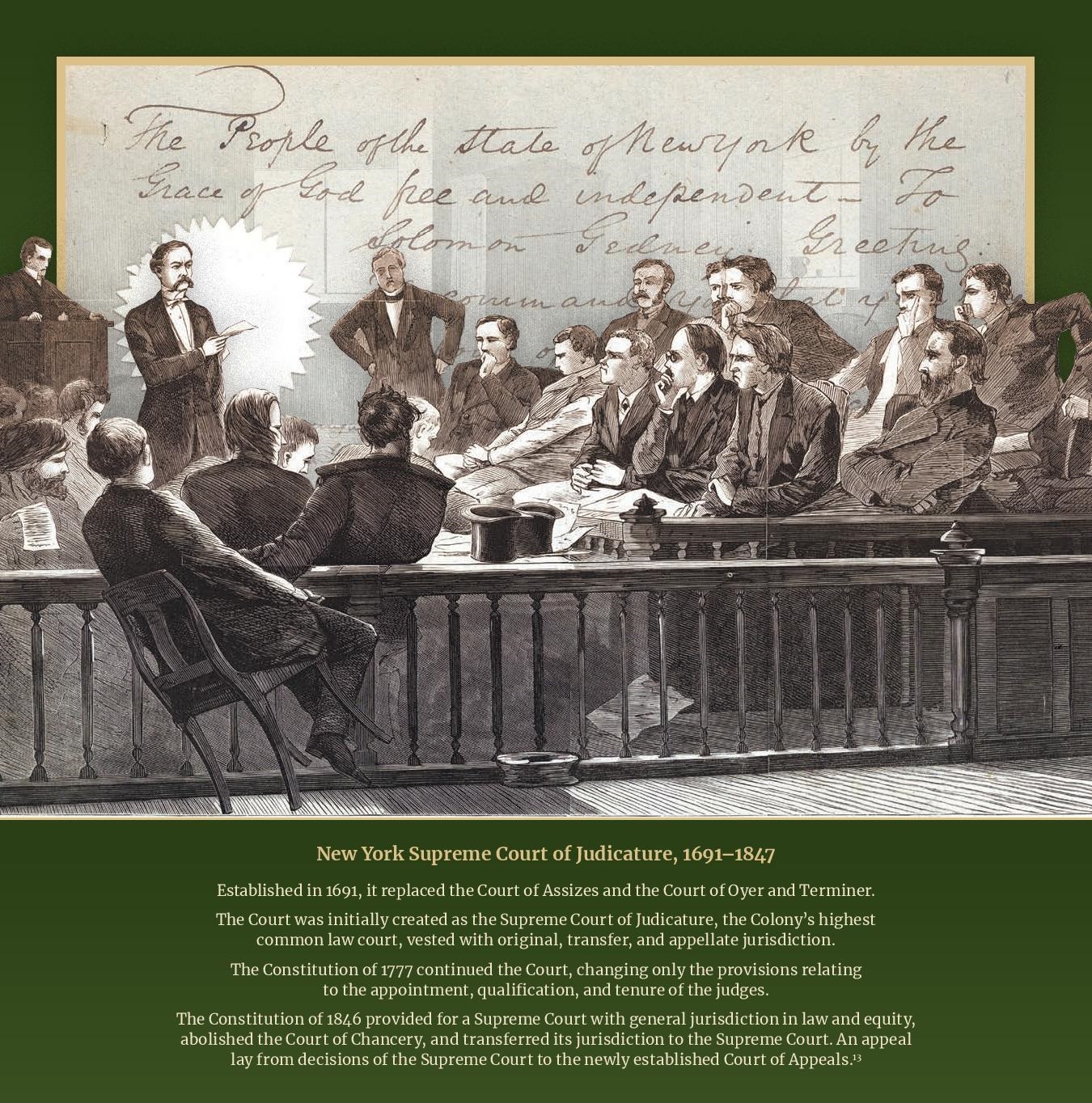
New York Supreme Court of Judicature, 1691-1847
Established in 1691, it replaced the Court of Assizes and the Court of Oyer and Terminer.
In “Duely & Constantly Kept”, 1691-1847, Dr. James D. Folts presents a history of the Supreme Court and an inventory of its records. The Court was initially created as the Supreme Court of Judicature, the Colony’s highest common law court, vested with original, transfer, and appellate jurisdiction.
The Constitution of 1777 continued the Court, changing only the provisions relating to the appointment, qualification, and tenure of the judges.
The Constitution of 1846 provided for a Supreme Court with general jurisdiction in law and equity, abolished the Court of Chancery, and transferred its jurisdiction to the Supreme Court. An appeal lay from decisions of the Supreme Court to the newly established Court of Appeals.[1]
[1] Sources and further reading: Historical Society of the New York Courts, NYS Supreme Court, https://history.nycourts.gov/case/supreme-court/; James D. Folts, Duely & Constantly Kept: A History of the Supreme Court of the State of New York, 1691-1847 (Second Edition, 2022); Henry Wilson Scott, The Courts of the State of New York: Their History, Development and Jurisdiction (1909); Charles Zebina Lincoln, The Constitutional History of New York (1906).
Images
Jurors listening to counsel during a trial in the Supreme Court of Judicature in the courtroom of the New City Hall (then the New York County Courthouse, more commonly known as the Tweed Courthouse), 1869. Smithsonian American Art Museum, The Ray Austrian Collection, gift of Beatrice L. Austrian, Caryl A. Austrian and James A. Austrian, 1996.63.73.
The writ of habeas corpus in People v. Gedney, the case in which Sojourner Truth—then Isabella Van Wagenen—sued Solomon Gedney in the Supreme Court of Judicature to free her son, 1828. New York State Archives, New York (State), Supreme Court of Judicature (Utica), Writs of Habeas Corpus, 1807-1832, J0029-82, Box 3.
November 2024
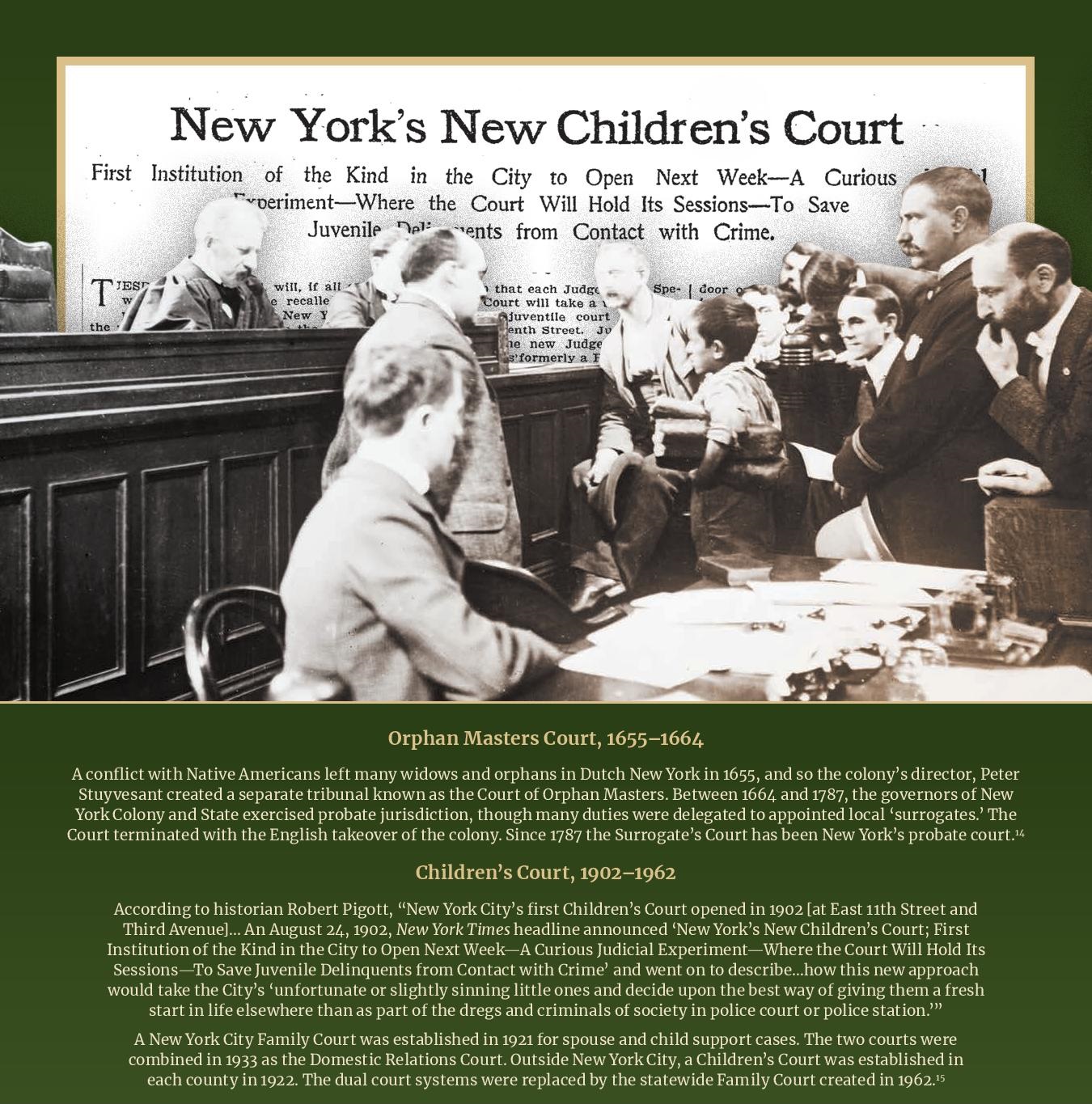
Orphan Masters Court, 1655-1664
A conflict with Native Americans left many widows and orphans in Dutch New York in 1655, and so the colony’s director, Peter Stuyvesant created a separate tribunal known as the Court of Orphan Masters. Between 1664 and 1787, the governors of New York Colony and State exercised probate jurisdiction, though many duties were delegated to appointed local ‘surrogates.’ The Court terminated with the English takeover of the colony. Since 1787 the Surrogate’s Court has been New York’s probate court.[1]
Children’s Court, 1902-1962
According to historian Robert Pigott, “New York City’s first Children’s Court opened in 1902 [at East 11th Street and Third Avenue]… An August 24, 1902, New York Times headline announced ‘New York’s New Children’s Court; First Institution of the Kind in the City to Open Next Week—A Curious Judicial Experiment—Where the Court Will Hold Its Sessions—To Save Juvenile Delinquents from Contact with Crime’ and went on to describe…how this new approach would take the City’s ‘unfortunate or slightly sinning little ones and decide upon the best way of giving them a fresh start in life elsewhere than as part of the dregs and criminals of society in police court or police station.’”
A New York City Family Court was established in 1921 for spouse and child support cases. The two courts were combined in 1933 as the Domestic Relations Court. Outside New York City, a Children’s Court was established in each county in 1922. The dual court systems were replaced by the statewide Family Court created in 1962.[2]
[1] Sources and further reading: Jaap Jacobs, New Netherland: A Dutch Colony in Seventeenth- Century America (Brill 2005) at 83-88, 171.
[2] Sources and further reading: Robert Pigott, New York’s Legal Landmarks (Second Edition, 2014) at 84, 91.
Images
The New York Times, August 24, 1902. Copyright The New York Times.
Children’s court in session in New York City, c. 1902. Library of Congress, Prints & Photographs Division, LC-B2- 454-7.
December 2024
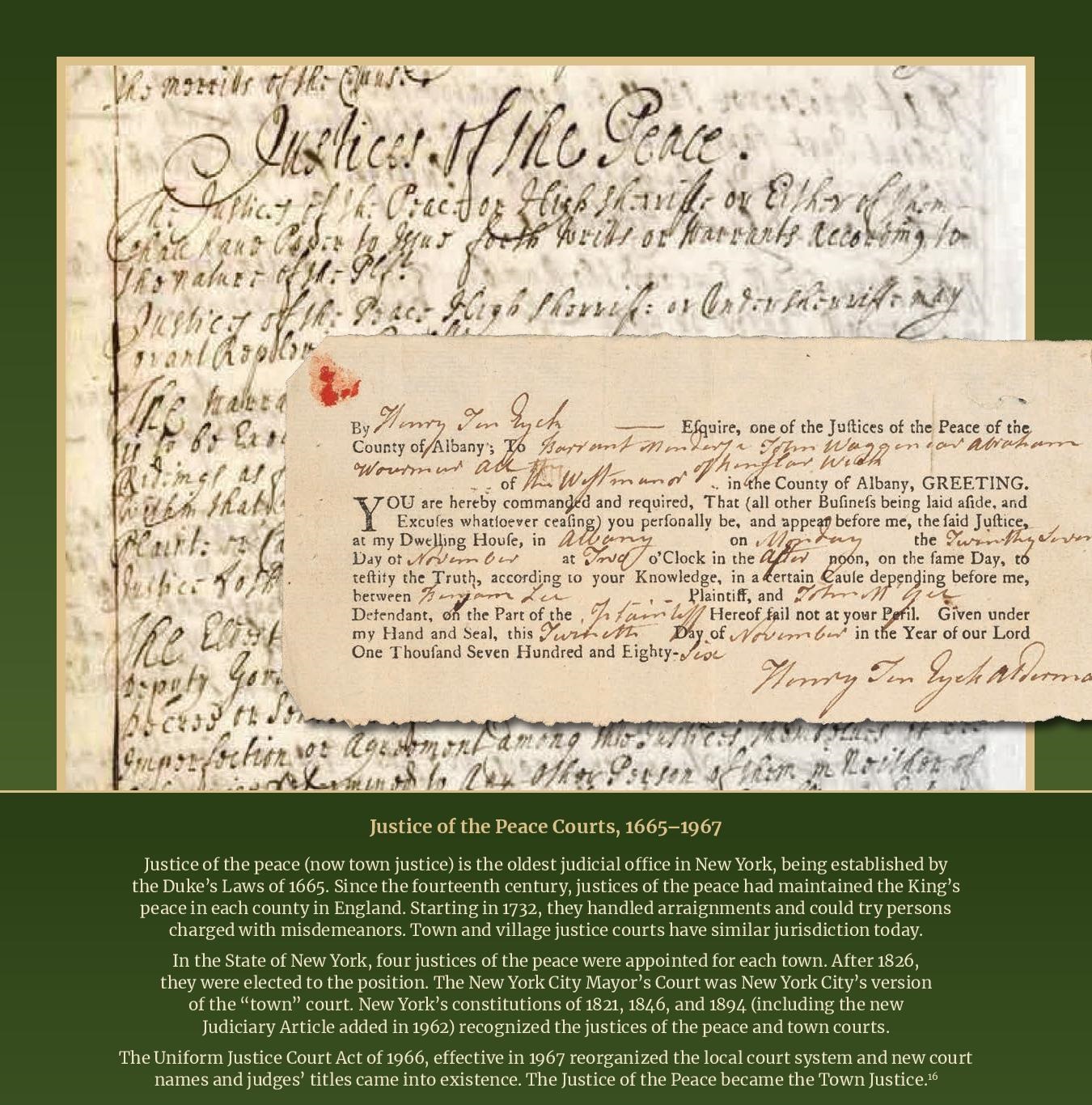
Justice of the Peace Courts, 1665-1967
Justice of the peace (now town justice) is the oldest judicial office in New York, being established by the Duke’s Laws of 1665. Since the fourteenth century, justices of the peace had maintained the King’s peace in each county in England. Starting in 1732, they handled arraignments and could try persons charged with misdemeanors. Town and village justice courts have similar jurisdiction today.
In the State of New York, four justices of the peace were appointed for each town. After 1826, they were elected to the position. The New York City Mayor’s Court was New York City’s version of the “town” court. New York’s constitutions of 1821, 1846, and 1894 (including the new Judiciary Article added in 1962) recognized the justices of the peace and town courts.
The Uniform Justice Court Act of 1966, effective in 1967 reorganized the local court system and new court names and judges’ titles came into existence. The Justice of the Peace became the Town Justice. [1]
[1] UJCA 102, 103. People v. Fatsis, 180 Misc. 2d 172, 173 (1999). From this case, “See, People v Mann, 97 NY 530, for a historical discussion of Justices of the Peace.”
Sources and further reading: New York City and New York State Legal Documents, Manuscripts and Archives Division, https://archives.nypl.org/mss/18159; New York State Unified Court System, Justice Court Manual, https://www.nycourts.gov/courts/townandvillage/FinalJusticeCourtManualforUSCsite.pdf; Chester H. Smith, “The Justice of the Peace System in the United States” 15 Cal. L. Rev. 2, 1927, 118–41; Special Commission on the Future of the New York State Courts, Justice Most Local: The Future of Town and Village Courts in New York State, http://www.nycourtreform.org/Justice_Most_Local_Part1.pdf; Charles Austin Beard. Office of Justice of the Peace in England in Its Origin and Development (1904).
Images
A notice to appear before Henry Ten Eyck, as Justice of the Peace of Albany County, 1786. The New York Public Library, Manuscripts and Archives Division.
Section on Justices of the Peace as outlined in the code of law known as the Duke’s Laws, 1665. Courtesy of the Historical Society of the New York Courts.

